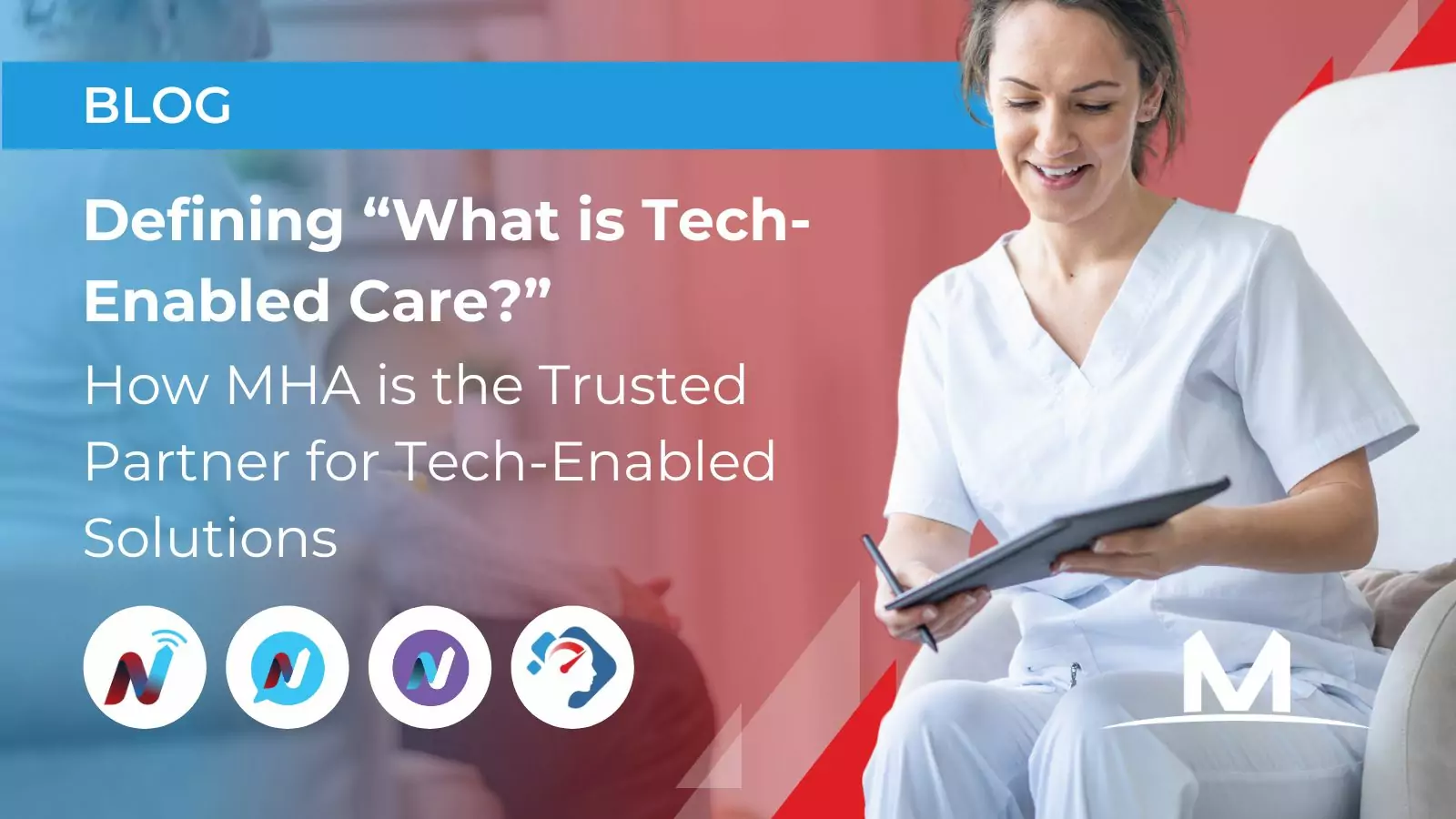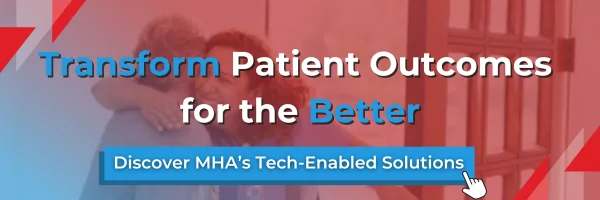What is Tech-Enabled Care: Exploring MHA’s Innovative Solutions for Home Health and Hospice

Author: Cole Sorensen
Posted: December 10, 2024
Discover How MHA's Tech-Enabled Solutions Enhance Patient Outcomes and Streamline Operations
As the landscape of home health and hospice care rapidly evolves, tech-enabled care is playing an increasingly pivotal role in the improvement of both the quality and efficiency of patient care. The utilization of technology to enhance patient care experience aims to maximize the well-being of both patients and caregivers. At MHA, we know that technology is not just a useful tool, but a necessity to provide the highest quality of care for those in need.
What is Tech-Enabled Care?
Tech-enabled care is defined as “fully integrated in-person and virtual care models that hybridize care delivery based on clinical appropriateness and other factors such as convenience and cost1.” These technological care solutions aim to ensure patients receive timely, high-quality services and can range from efficient caregiver scheduling tools to text-based patient notifications.
As more hospice and home health agencies turn to tech-enabled care to achieve better patient outcomes, we at MHA recognize the growing need for efficient, compassionate care tools. That’s why we’re driving the creation of innovative tech-enabled solutions that help agencies thrive and deliver the highest quality of care. Our line of tech-enabled tools is designed to enhance every aspect of agency operations, from streamlining back-office processes to optimizing the care provided by frontline clinicians.
Automation and Workflow Improvements
One of the top advantages of implementing tech-enabled care into home health and hospice agencies is streamlining administrative tasks like clinician scheduling. With post-acute care providers facing concerns such as missed patient visits and decreased agency productivity, clinician scheduling inefficiency is a critical issue on many agencies’ radars. When clinicians miss visits with patients, the costs of doing so negatively affect the agency’s revenue, and patient care is greatly hindered4. Implementing tech-enabled tools can relieve some of the tedious tasks associated with traditional scheduling while giving managers greater insight into their staff’s productivity to make more informed decisions.
MHA’s own Caregiver Accelerator is a great example of an innovative tech-enabled solution working to ease workflow inefficiencies within hospice, home health, and post-acute care. With customizable dashboards that managers can utilize to track clinician trends and productivity, Caregiver Accelerator optimizes the scheduling process and gives agencies greater insights into their staff’s productivity. From swift filtering of caregiver types to real-time updates, Caregiver Accelerator enables more efficient decision-making and better patient care.
Roles of Telehealth in Home Health and Hospice
In home health and hospice care, the use of telehealth has been proven to optimize patient care across many facets such as access to care, patient outcomes, and more2. Telehealth allows clinicians to establish timely consultations, follow-ups, and a direct line of communication between patients and caregivers.
The absence of efficient tech-enabled tools in telehealth workflows can become problematic for both agencies and patients due to the lack of communication, which can ultimately lead to confusion for patients about when their caregiver will be coming to them or what type of care they need. These inconsistencies can harm both care outcomes and the caregiver-patient relationship—and even cause patients to lose trust in their caregivers3. Agencies that fail to adopt tech-enabled communication tools between clinicians and patients run the risk of missing opportunities to provide the highest standard of care.
So how can home health and hospice agencies elevate their telehealth workflows? The MHA team created tech-enabled care solutions like NOTIFYnana and nanaCONNECT to optimize communication between clinicians and patients.
NOTIFYnana
NOTIFYnana is a text-based notification solution that keeps patients informed about the arrival of their caregiver. By sending text updates to patients, clinicians decrease missed visits and enhance the continuity of care and patient satisfaction, improving overall care and outcomes such as:
- Timely interventions
- Increase patient adherence and satisfaction (HHCAPHS scores)
- Overall communication
nanaCONNECT
nanaCONNECT stays seamlessly connected to patients’ well-being through daily text-based alerts and messages. nanaCONNECT functions as a Remote Patient Monitoring tool (RPM), where caregivers engage with their patients by receiving real-time insights on how they are feeling. Patients don’t need to wear a medical device at all times, but rather have a device on hand to text their clinicians via nanaCONNECT if their health changes. This enables caregivers to quickly adjust care plans depending on responses. Key features include:
- Daily texts for ensuring timely check-ins
- Simple rating system to establish how a patient is feeling
- Alert system if patients’ well-being falls below a defined threshold
- Customizable messages to add personal touches to every interaction
Beyond physical home health and hospice care, bereavement services can also benefit from tech-enabled tools to enhance support to grieving individuals. MHA’s nanaBEREAVEMENT harnesses technology to do just that, providing an effective and cost-saving way to provide bereavement support.
nanaBEREAVEMENT
nanaBEREAVEMENT introduces an efficient, personalized approach to bereavement communication by replacing traditional letters with text messages. This tech-enabled solution for hospice agencies ultimately enhances support through tailored messages based on risk assessment and streamlines the communication process and provides benefits like:
- A more modern, efficient text-based messaging system
- Enhancement of personalized and continuous bereavement support
- Improved communication between agencies and families
- Cost reduction from traditional paper-sent letters
nanaBEREAVEMENT is certified by the Accreditation Commission for Healthcare (ACHC) as of October 2024. ACHC accreditation affirms nanaBEREAVEMENT as a trusted tech-enabled care solution grounded in bereavement best practices and aligned with national quality and safety standards.
A Tech-Enabled Future — The MHA Difference
The shift towards tech-enabled care for home health and hospice agencies is no longer an emerging trend, but rather a necessity in the industry’s disruptive environment. By leveraging tech-enabled solutions, agencies can deliver higher quality and more efficient care that strategically meets the needs of patients. Whether through workflow automations to increase productivity or more efficient communication services, the integration of tech-enabled care allows caregivers to focus on what matters most: providing high-quality care to those who need it most.
Is your agency ready to implement efficient, tech-enabled solutions that optimize all facets of your operations? At MHA, we know what tech-enabled care is and how to maximize the care of your patients and grow your agency’s revenue with our tech-enabled solutions. Let’s work together to achieve the best outcomes for your agency and your patients! Visit us at www.maxwellhca.com, or contact us at [email protected] to get started.
Resources:
- American Medical Association. Return on Health: Moving Beyond Dollars and Cents in Realizing the Value of Virtual Care. Chicago: American Medical Association, 2020. https://www.ama-assn.org/system/files/ama-return-on-health-report.pdf.
- Chisholm, James C., et al. "Intrauterine Devices and Risk of Endometrial Cancer: A Case-Control Study." British Medical Journal 319, no. 7207 (1999): 1475-1479. https://www.ncbi.nlm.nih.gov/pmc/articles/PMC11298029/.
- Ha, Jee-Yeon, and Florence R. Meyers. "Miscommunication between Patients, Relatives, and Health Care Professionals in Emergency Medical Care." Materials 3, no. 1 (2024): 43-56. https://www.mdpi.com/2673-527X/3/1/4.
- Levey, Noam N. "Missed Visits, Uncontrolled Pain, and Fraud: Report Says Hospice Lacks Oversight." *KFF Health News*, September 19, 2023. https://kffhealthnews.org/news/missed-visits-uncontrolled-pain-and-fraud-report-says-hospice-lacks-oversight/.

